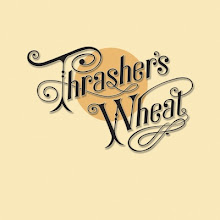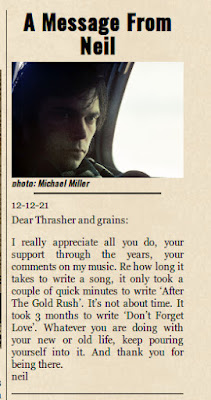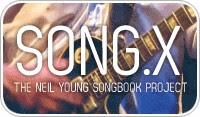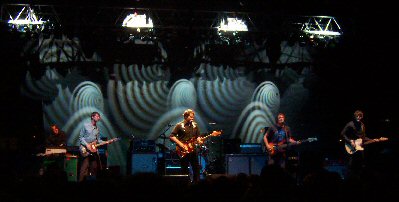Comment of the Moment: Neil Young & Crazy Horse's 'ODEON BUDOKAN'
Earlier, we posted on Mastering Neil Young & Crazy Horse's 'ODEON BUDOKAN' on Vinyl.
The legacy of the 'ODEON BUDOKAN' tapes is somewhat tortured as noted in a comment by wardo:
"SRS 04 on the cover, SRS 03 on the labels, PS 06 on Archives."
Which brings us to our Comment of the Moment on Mastering Neil Young & Crazy Horse's 'ODEON BUDOKAN' on Vinyl by Tomatron:
That there Archives project by Neil Young sure is a work in progress.
Kudos to Wardo and his eagle eyes on catching that vinyl label discrepancy. Around here such a blowup requires reading glasses used in conjunction with the magnifying glass app, and quite possibly a modicum of squinting. But that designation is not the only difference between the label and the superior new cover. The label says “2019 Silver Bow Productions”, as opposed to “2023 The Other Shoe Productions”, although both productions are proudly “Inc.”
What does it mean? This is no mere misprint. Odeon Budokan has been in production for 4 years. In 2019, it was intended to be SRS 03. Pressing was shelved, likely for the usual, global upheaval, reasons. (It’s also possible that the vinyl was already pressed snd they were only waiting for the artwork, or didn’t want to detract from the imminent release of the box set.)
Regardless, it came out as part of Vol. 2, but those discs aren’t marked other than by number within the set, Disc 10, for example. Performance Series 6 was added to NYA’s online version of the album, but of course that sort of thing can and does change all the time as Neil’s team adjusts the catalog. It’s just text on a screen, and may be different next time the page loads.
But once Odeon Budokan was back on the docket, the decision was made to: 1. Change it back from PS to SRS (makes sense, since it was meant to come out in ‘76 just like the other Special Releases were planned for their moments), 2. Move it from SRS 03 to 04, which points to another possible mid-70s shelved album yet to come to light, and 3. Keep the old labels, because why waste them, and who’s going to notice that tiny number anyway?
Of course, this points to a freed-up PS 6. NYCH late ‘76, anyone? What about SRS 03? Are there rumors circulating about any more lost albums between Homegrown and Odeon?(Assuming Neil and his team make the bold decision to PLEASE FOR THE LOVE OF GOD KEEP THE SPECIAL RELEASE SERIES NUMBERING IN CHRONOLOGICAL ORDER.)
Thanks for the CotM Tomatron and the excellent historical recap of OB. And thanks wardo for inspiration here on proofreading. Lots of good observations on 'ODEON BUDOKAN'.
Hopefully, NYA will hear the cries of our rustie grain friends.
More on Mastering Neil Young & Crazy Horse's 'ODEON BUDOKAN' on Vinyl.
Neil Young & Crazy Horse's 'ODEON BUDOKAN'
Labels: #CrazyHorse4HOF, album, concert, crazy horse, live, neil young, vinyl

































 Human Highway
Human Highway

















 Concert Review of the Moment
Concert Review of the Moment





 This Land is My Land
This Land is My Land

 FREEDOM In A New Year
FREEDOM In A New Year









 *Thanks Neil!*
*Thanks Neil!*




![[EFC Blue Ribbon - Free Speech Online]](http://www.thrasherswheat.org/gifs/free-speech.gif)











 The Unbearable Lightness of Being Neil Young
The Unbearable Lightness of Being Neil Young Pardon My Heart
Pardon My Heart



 "We're The Ones
"We're The Ones  Thanks for Supporting Thrasher's Wheat!
Thanks for Supporting Thrasher's Wheat!




 This blog
This blog 
 (... he didn't kill himself either...)
#AaronDidntKillHimself
(... he didn't kill himself either...)
#AaronDidntKillHimself









































































 Neil Young's Moon Songs
Neil Young's Moon Songs




 Civic Duty Is Not Terrorism
Civic Duty Is Not Terrorism Orwell (and Grandpa) Was Right
Orwell (and Grandpa) Was Right


 What's So Funny About
What's So Funny About 



24 Comments:
I have repeatedly offered my proofreading services and skills to the NYA team. I've also offered to play bass. Neither offer has been acknowledged.
wardo this is borderline unconscionable. oh, the humanity. this aggression will not stand.
Thanks thrasher. Yet somehow, I carry on.
My key impression of Odeon Budokan is how effective Cowgirl in the Sand remains as a concise, meaty slab of proto-grunge electric Horse. After spending years with the classic drawn out renditions of EKTIN, Fillmore, and Red Rocks, this was a refreshing surprise when first listening to NYA2. Although I’ll always champion the Red Rocks/Road Rock recording for its trance-like structure and lumbering beauty, the Budokan take is satisfying even in its brevity.
Like Cowgirl, the live album as a whole is energetic and tight. Judging by the electric arrangements in particular, sleekness of form is what NY and the Horse were going for at the time. The album is well-balanced between acoustic mellow and electric crunchy. It sounds to me like this dualistic shape became the inspiration and deep structuring principle of Rust Never Sleeps. NY’s best, most interesting albums frequently have a yin and yang tension at play, simultaneous contrast in sound. Such a frisson between spirit and matter is perhaps the root of good art.
Edit: Please kindly pardon any possibly superficial and sloppy pseudo-philosophizing. I’m aware such things have sparked touchy responses in the past. I shouldn’t have to write a disclaimer on a blog post, but none of this is intended to meet peer review standards or impress a thesis committee. I’ve jumped through some of those hoops. My goal here is to communicate clearly to the broadest audience, an important objective if we wish to make productive change.
Peace.
This comment has been removed by the author.
Meta, this was my impression upon listening to the album as a standalone release as well; Odeon Budokan is the "quick n dirty" version of NYCH. That feel is especially evident on the electric side, since they're known for those extensive jams, from early daze to 21st century sets. There's a rapidfire energy to the tracklist here.
Like most fans, I think I'd prefer a double album to really stretch out and enjoy the vibe, even if the songs themselves are brief. Live albums are usually better longer, since that's an analogue of the listening experience of the concert itself. But this is a different kind of live album, almost a sampler of what you might get at a Crazy Horse show, instead of the full deal. It's not a bad introduction to the artist, and would've been a great way to hype up the Fall '76 tour if it had been released that summer.
And it is very much a prototype for Rust Never Sleeps! Fun to think about Young and Briggs having this concept ready to go, and just waiting for the next tour to make it happen. They really perfected the two-sided format with RNS, taking more of the Time Fades Away approach of using all new songs from a live setting.
Anyway, I prefer Odeon Budokan on vinyl, removed from its NYA Vol. 2 anticlimactic position. It's a legendary album with an idiosyncratic sequence that deserves to be spun on its own merits.
I remember something, maybe it is in Shakey (the book), about the 1976 tour as being one of the best in rock history. Maybe it was an old review from Rolling Stone, I can't recall. Does it rival the Rust Never Sleeps tour? Is it really different? You guys seem to know about this. Did Neil do an acoustic set on this tour?
The 1976 so-called World Tour, sometimes also labelled as the "The Rolling Zuma Tour" was the first Neil Young tour reaching out to continental Europe (with the exception of two CSNY shows in Kopenhagen and Stockholm in 1970) Given the audience response back then it is quite remarkable that it took six years for Neil Young and his management to decide to return to Europe (Trans Tour in 1982). Maybe record sales and exchange rates weren't favourable enough?
But then with Punk music being the latest hype in the late 70's and the beginning of the 80's they maybe believed there was no European market for them. Still I wonder why they decided to advertise the European "Trans Tour" as being "Live Rust '82".
Later on, understanding his European fans proved to be a challenge for Neil Young (see sympathy for some Reagan politics). It appears as if it took until 1987 that Neil Young and Lookout Management seriously were considering European legs or whole seperate tours behind new projects and releases on a more regular basis.
Thanks Abner and Dionys and all for insights.
Fyi, on a little TW hiatus and will be getting back later in the week.
Kinda of off topic but then again not so much. During these last few months, I have found myself stuck in a time warp investigating the period of 1974 to 1978 and Neil Young’s activity within it.
It’s a period I remember well as I was 15 going on 19 during this time and it was during those 48 months or so when my interest in Mr. Young really took hold. The albums of this period On the Breach / Zuma / Long May You Run / American Stars ‘n Bars / Comes a Time / Rust Never Sleeps are for me an incredible enjoyable run of albums that I will likely never tire from. At that time, I had no idea of the trunk load of material left in Neil’s vault although as time went by cracks in the safe door allowed tracks from this period seep out onto Decade, Hawks and Doves and later albums.
Now thanks to NYA and the passage of time we find ourselves (the humble NY fan) suddenly flooded with the recent releases of Homegrown, Hitchhiker, Chrome Dreams and of course Archives II which is our entry way to the time warp that is the incredibly creative time that Neil found himself in back between 1974 and 1978. The endless fun all this material provides us to explore alternative universes back during this time is proving to me endless fascination and I am not so sure when I will return to our current state anytime soon.
@Tomatron got me really thinking with his comment above “Anyway, I prefer Odeon Budokan on vinyl, removed from its NYA Vol. 2 anticlimactic position. It's a legendary album with an idiosyncratic sequence that deserves to be spun on its own merits.”, particularly the word anticlimactic. I found this an interesting point of view and as I thought about, I am not so sure anticlimactic is the correct word, to me Budokan is more of a milestone in the journey Neil was leading him on his way to 1978 and pair of Rust albums that were a fitting climax to the past 48 months that started back in 1974.
A quick history of Neil’s work back at this time is interesting in and by itself.
• 1974 – On The Beach released, possible CSNY album Human Highway, CSNY summer tour, recording sessions album Homegrown (unreleased at this time), possible album Mediterranean.
• 1975 – Crazy Horse sessions, possible CH album Ranch Romances, Zuma released, CH Northern California tour.
• 1976 – Crazy Horse tour Japan and Europe, Odeon Budokan(unreleased at this time) possible CSNY album Human Highway, Long May You Run released, Stills Young aborted tour, Hitchhiker (unreleased at this time), CH US fall tour.
• 1977 – Chrome Dreams spring (unreleased at this time), American Stars ‘n Bars released, Ducks summer tour, Decade released, Miami Music Festival.
• 1978 – Solo at the Boarding House spring, Crazy Horse summer / fall tour – leads to Rust Never Sleeps and Live Rust in 1979, Comes a Time release October.
Part 2 next.
Looking at that timeline it is astonishing to think there was enough material to release around 15 albums in different track listing combinations in a 4-year period. No wonder Neil had trouble settling on anyone album configuration during this time. It is a fun game to come up with your own “Lost” album using all the material now available to us via NYA and the albums that followed this time period where a lot of these songs slowly got official release (sometimes radically reinterpreted). One I made I titled “Doves” using side one of Hawk and Doves and made side two consists of Star of Bethlehem, Will to Love, Pardon My Heart, Lookout For My Love, Music Arcade and To Far Gone. Yes, Music Arcade is a bit of a cheat, but it fits really nicely IMHO.
What a period for Mr. Young he really could do no wrong at this time, but with Odeon Budokan right in the middle of this activity you can see why I say back at the tope of this post that I see this live album more as a milestone in a journey than anticlimactic. Once Archives III is released this will provide further evidence of this and likely even more possible album configurations.
For more on some of these lost albums visit - https://the-reconstructor.blogspot.com/search?q=neil+young and https://albumsthatneverwere.blogspot.com/search/label/neil%20young.
Thrasher, we'll try and keep the home fires burning for the time being!
For me, Chrome Dreams encompasses the best parts of Stars 'n' Bars--i.e. most of side 2. Personally, I've never been inspired by side 1 and would argue Chrome Dreams is a stronger album track by track. Saddle up the Palomino and Bite the Bullet are disposable. Old Country Waltz and Hey Babe are (and I'm trying to be polite here) not bad but generic. (To be fair, I find the Waltz considerably more affecting as a solo piano piece on Hitchhiker.) Hold Back the Tears is stronger, but I'll have to listen closely to the solo Chrome Dreams version to see where I fall on that.
In short, NY's generic country-flavored stuff has never excited me. I have the same problem with side 2 of H&D. However, what strikes me as flat and bland might be positively refreshing for someone else, so I'm beyond grateful the Archives give us so many choices about how to listen to the catalogue.
I will admit it puzzles me how side 1 of Stars 'n' Bars came to be, given that there was so much material available that is (to my mind) obviously better. On the other hand, if CD had come out in '77, Rust Never Sleeps would not exist as we know it. With both Powderfinger and Sedan Delivery on CD, side 2 of RNS would have been completely gutted.
It may be that tradeoffs are inevitable when it comes to curating such an immense volume of high quality material. And curation is the key word, especially when talking about the Archives. From the format changes (CD, blu-ray, vinyl, hires website) to the configurations of PS, SRS, and choice of box set contents, the underlying challenge has always been one of how to present the wealth of material, which cuts to include, what order to release albums in, and for that matter, the question of what even constitutes an album?
In recent posts, tomatron has been doing exemplary work in showing what alternate discography timelines could have looked like if, for instance, Hitchhiker came out in '76 or Chrome Dreams in '77. The point, for me, is that through the Archives, it becomes possible to have both options, where they would ordinarily be considered mutually exclusive. The NYA experience is not quite as strictly linear as it may initially seem.
The shape of the Archives, such as is currently known, reflects the activity of a creative mind at work, with ideas and songs constantly in flux. The release of Toast, with its selection of Crazy Horse renditions of AYP? tracks, should have alerted us to this multi-faceted structure where there isn't necessarily any "real" or "original" version of a particular song. However, most of us are more intimately familiar with, and attached to, the material on Chrome Dreams in its many past configurations (Stars 'n' Bars, Decade, Rust, Hitchhiker, Homegrown), so I suspect the contingent aspect of the Archives (and the Special Release series in particular) is more strongly underlined when it directly touches on the classic albums.
Kevin, I'm always interested in hearing about other folks' curated Neil playlists. I've done enough of my own over the course of several years, and yes, I am prone to occasional "cheats", too, in terms of sticking tracks from totally different eras together. For instance, I had Safeway Cart (SWA) side by side with Human Race (from Barn) at one point.
This should be a clue to my confidence in the strength of much of Neil's newer material to stand alongside the classics. I'll have to dig up some old playlist notes and post at some point. I got a lot of mileage out of NYAII when it came out in 2021--all kinds of arranging and rearranging you can do with that material. If I recall, Like a Hurricane was back to back with the Stills/Young Band take of Separate Ways on one of these lists, which likely also included Long May You Run, Mediterranean, and Stringman among others.
Kevin, that sensation of being stuck in time is relatable! Back-to-back vinyl releases of Chrome Dreams and Odeon Budokan have dropped us right into that era. This is a time in which I came to exist but have no memory of.
I’m glad you brought up that “a” word as I have been reconsidering the description. In terms of closing out the box set as Disc 10, it does work better than the tracks later recorded with S and C&N, and you can never go wrong with Cortez The Killer, which might actually be my single favorite song of all time.
Climactic enough! But something left me uneasy about O-B’s placement in the set. My conclusion is the sheer brevity of it, especially in context of the entire compilation, was underwhelming. (See earlier comments about short live albums.) Divorced from that setting, the album takes on a new life for me. It’s a Special Release through and through, yet another window into what might have been.
Compared to what was to come in future years the March 1976 Japan/Europe was quite a simple affair. Neil would come on first and do a solo acoustic set of 8 or 9 songs, and then after a short intermission would come back with Crazy Horse for an electric set of 9 or 10 songs. The longest shows had only 19 songs and total running times of just under two hours. The entire tour was only a month long, visited only 16 cities and comprised 22 shows in total – 7 in Japan and 15 in the UK.
The performances were also very straightforward with none of the theatre that came with Rust Never Sleeps for example. For the acoustic set Neil would just walk on and sit on a chair and start playing with pretty much just a single spotlight. The electric set had a bit more lighting but was basically just four young guys playing their music for their and the audience’s enjoyment.
I was at the Glasgow show that was the last night of the tour. It wasn’t intended to be the last night, but demand for tickets in London was such that they added a 4th show there on the original Glasgow date, and bumped the Glasgow one to after the London shows. (We might not have got the film of Neil busking The Old Laughing Lady on the banjo at Glasgow Central station on the day of the show if this hadn’t happened – I think he had some time to kill).
My memories are of outstanding performances of old, recent and brand new songs, and very enthusiastic and positive audience reaction. At the time none of us knew what to expect – there was no internet then and we were dependent on musical newspapers like the NME for any information. Zuma had been released the year before, and the last time Neil had played in the UK was the Tonight’s The Night tour. I loved Zuma, and was also very fond of AFTG, Harvest and EKTIN so the acoustic/electric format and the setlist very much met with my approval. In fact if I was to go and see Neil perform today and it was the same setlist I would be delighted.
The electric set had the most impact on me at the time as I had never seen or heard performances like these before. It was very rare to get any rock music on TV at the time, but I had seen the BBC In Concert footage so the style of the acoustic set was no real surprise. What I hadn’t experienced before was the long electric jams and Neil’s extended guitar soloing. And of course the absolute highlight of this was when Neil casually said ‘Here’s another new song for you’ and launched into Like a Hurricane. This was a jaw-dropping performance, particularly when Neil was soloing in front of a giant electric fan, his long hair and clothes ‘blown away’ as he played.
It was over all too soon, but the memories have remained. A friend who was with me remarked he hadn’t expected Neil to play so many of his favorite ‘old songs’. None of us would ever have imagined Neil would still be playing old and new songs for us nearly 50 years later.
Just wanted to add that looking back and with the benefit of hindsight perhaps the most significant thing about the Japan/Europe tour was that it was the start of the Poncho era of live Crazy Horse performances. So much was yet to come...
Regarding the Odeon Budokan album I share Tomatron's thoughts on it's brevity. It is really only half a show, and some of the tracks were rarely performed on the tour, e.g. Stringman was only played once, The Old Laughing Lady twice, and even Cowgirl was only played 5 times.
If it had been released in 1976 though my biggest surprise would have been the omission of Like A Hurricane. It was played every night and was an absolute standout. Perhaps Neil and Briggs wanted to save it for a studio album i.e Stars and Bars or as we now know Chrome Dreams. Having said that I actually enjoy listening to Odeon Budokan now as a live sampler as Tomatron suggests.
I have also been enjoying listening to CD, as a collection of classic Neil tracks, and as many have said it is mind boggling to enter the world of what if regarding what the Neil Young catalogue of albums would have looked like if different choices had been made about what albums were actually released. I am reminded of a quote from Poncho where he said Neil would ring him up to tell them they were releasing album and Poncho would say 'Oh yeah - what's on it?'
Perhaps the NYA timeline is the best way to explore Neil's music now, with the ability to see what was recorded when in chronological order rather than album order.
Speaking for myself, NYA as a whole has afforded me great freedom in how I can choose to experience Neil's music. I don't feel glued to any one period. If anything, NYA allows the listener to inhabit the past and the present at the same time, neatly squaring the circle.
I'm all for living in the present, so I just need to stress my conviction that the best of NY's current music can happily stand alongside the classics. We're speaking of an artist who never produces the same album twice. The new and the old are different from each other, but one is not necessarily superior to the other. Albums like Storytone and The Visitor, for me, represent an artistic renaissance, to say nothing of the recent run of albums with the Horse (because we've all said a lot about those already).
Different songs for changing seasons. Eventually the new becomes the old, so why get stuck in a linear, temporal frame of mind anyhow? Art has at least the potential to be that which exists in a permanent present (paradox alert). Although it certainly reflects the moment in which it was created, it can remain, in another sense, ageless--as long as humans don't set out deliberately to destroy it.The NYA edifice is a good example of the progression of technology toward allowing the preservation of cultural productions and works of art in pristine shape.
Unsystematic musings, partly because of limited command of the anglo-saxon idiom: This alternative approach to Neil Young's body of work (or are they bodies?) is quite refreshing. But then: the human mind by its own experience is linked or even chained to the time axis with little chances to escape it now and then. So when Neil Young started to sing about "mother nature on the run" and over the decades changed the lyrics around to fit the respective dates (we are into the "twenty first century" ATGR-version now) he at the same time and paradoxically affirmed the time axis. Also in appreciation of the aforementioned "bodies", style changes, turning points, and paradigm shifts always create a "before" and "after". To follow Neil Young's twists and turns is no small part of the fun. The German movie director Alexander Kluge once said "The present is an attack on all the other times." Filling the gaps of a discography is one thing, re-writing the past another and questionable undertaking. "It's easy to get buried in the past" and therefore I do hope that there still is some considerable future left for new Neil Young records as opposed to new releases of old material.
just checking back in after spending some time on the beach.
thanks for keeping the homefires burning Meta Rocker & all!
And Ron! Awesome memories on 76 NYCH! See
http://neilyoungnews.thrasherswheat.org/2023/09/flashback-memories-of-neil-young-crazy.html
the permanent present is perhaps not a paradox but a contradiction. I am stuck in the linear because time is a condition of all human thought and experience. But the idea is fun to think about. On the other side of the paradox is the notion that art might be about our attempts at a permanent present, a tragic attempt, and a definite thread in tragic literature. The defiance of our own condition is frequent and subtle.
Neil is very good at marking time, which is conditioned by time's arrow.
Stars n Bars is “one of my favorite” NY albums (top 15) I had a ripped-from-vinyl CD copy of it in 2000 long before it became available again. I savored it. I loved Bite The Bullet before I was lucky enough to see NY & CH play it live many times in 1996, OPL, up close. I see that song as an essential classic in the Neil Young catalogue. Saddle Up the Palomino is another great song, not a cold bowl of Chile, in my opinion.
But there is no accounting for taste, as my late buddy used to say.
Ain’t it the Truth?
Your brother Alan in Seattle
@Dionys, Please don't mistake my personal writing style for a perfect representation of the "Anglo-Saxon idiom"! I don't know of many people who write quite the way I do, i.e. idiosyncratically and sometimes haphazardly.
@Abner, "permanent present" is a clunky approximation of the concept I was trying to illustrate, but one is always struggling with the limitations of human language. Ancient texts like the Bhagavad Gita and the Hermetica discuss time as a circular rather than linear process. The most down-to-earth example being the seasonal patterns but if you dig deep enough, you can find all sorts of discourse on cosmogonic cycles, along with the idea that we get might get closer to god/the divine by trying to envisage ourselves outside of linear space-time, which is not a state we readily have words for.
From the ancient Greco-Egyptian Hermetica: "Leave behind the material world and imagine yourself unbelievably expansive. Rise out of time to eternity [...] Embrace within yourself all opposites--heat and cold, hard and fluid. Think yourself everywhere at once--on land, at sea, in heaven. Imagine yourself unborn in the womb, yet also young and old, and already dead, and in the world beyond the grave. See that everything co-exists in Mind" (trans. Freke & Gandy 1997).
Therefore, "permanent present" represents my meager effort to find a simple term that can encapsulate a state of transcendence where all possibilities exist simultaneously. It is, as you say, fun to think about, but I appreciate your grounded realism (or is it pessimism?) as a healthy counterpoint to my admittedly speculative leanings. It's important to have both, so as not to be carried away by either the tragic or the ecstatic.
Post a Comment
<< Home